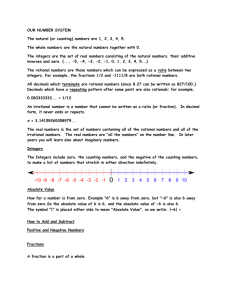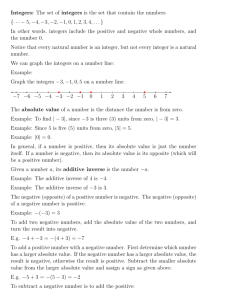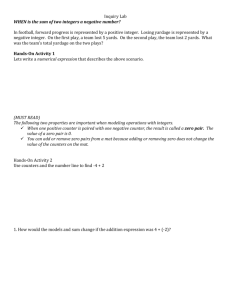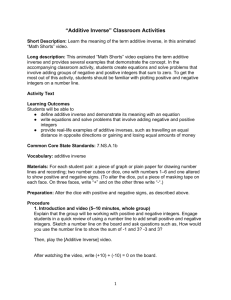Additive Inverse Student Probe Lesson Description Rationale
advertisement
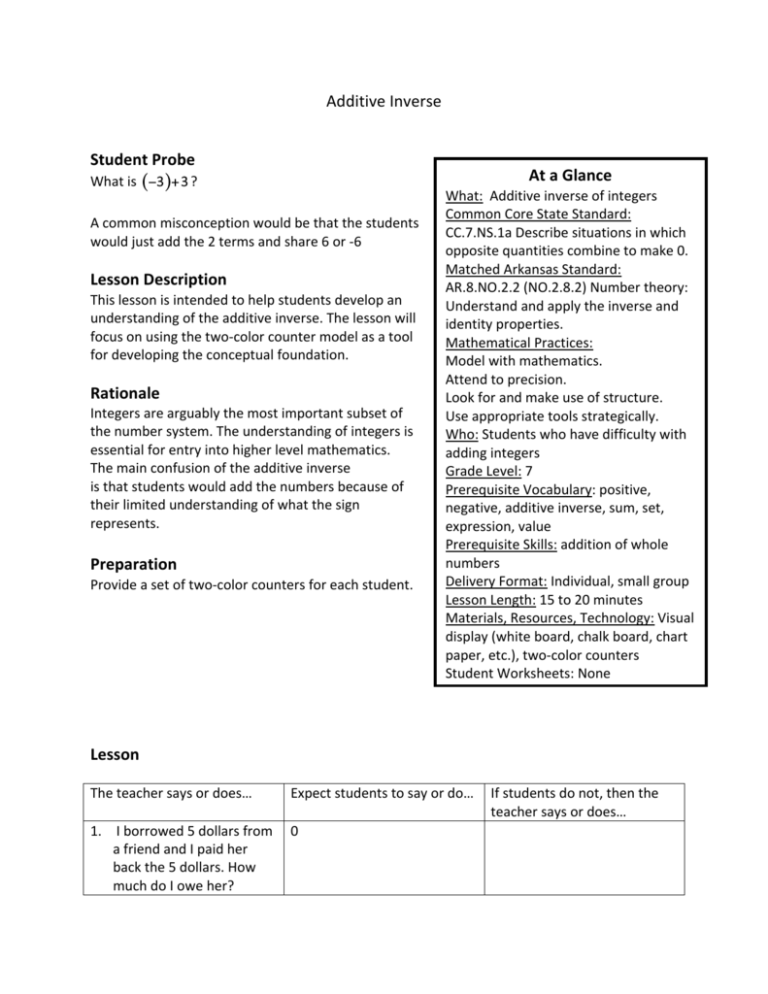
Student Probe What is Additive Inverse ? A common misconception would be that the students would just add the 2 terms and share 6 or -­‐6 Lesson Description This lesson is intended to help students develop an understanding of the additive inverse. The lesson will focus on using the two-­‐color counter model as a tool for developing the conceptual foundation. Rationale Integers are arguably the most important subset of the number system. The understanding of integers is essential for entry into higher level mathematics. The main confusion of the additive inverse is that students would add the numbers because of their limited understanding of what the sign represents. Preparation Provide a set of two-­‐color counters for each student. Lesson The teacher says or does… At a Glance What: Additive inverse of integers Common Core State Standard: CC.7.NS.1a Describe situations in which opposite quantities combine to make 0. Matched Arkansas Standard: AR.8.NO.2.2 (NO.2.8.2) Number theory: Understand and apply the inverse and identity properties. Mathematical Practices: Model with mathematics. Attend to precision. Look for and make use of structure. Use appropriate tools strategically. Who: Students who have difficulty with adding integers Grade Level: 7 Prerequisite Vocabulary: positive, negative, additive inverse, sum, set, expression, value Prerequisite Skills: addition of whole numbers Delivery Format: Individual, small group Lesson Length: 15 to 20 minutes Materials, Resources, Technology: Visual display (white board, chalk board, chart paper, etc.), two-­‐color counters Student Worksheets: None Expect students to say or do… If students do not, then the teacher says or does… 1. I borrowed 5 dollars from 0 a friend and I paid her back the 5 dollars. How much do I owe her? The teacher says or does… Expect students to say or do… If students do not, then the teacher says or does… 2. Today we are going to experience and study the additive inverse property. Distribute color counters to students. Explain that yellow is the positive side and red is the negative side. 3. What does this represent: 4 4. Can you represent a positive 5? 5. What does this represent 6. Represent . 7. What is the opposite of negative positive? 8. Can everyone give me the opposite of this representation 9. What would we call this representation? What kind of 4? What does the yellow represent? What color should you use? Is it positive or negative? How many are there? What color should you use? Is it positive or negative? What color should you use? How many are there? Is it positive or negative? How many are there? The teacher says or does… 10. What would we call this representation? 11. How could I represent “Put one and one together”, or write 1+1 12. Can you use the two color counters to represent “Putting 1 and its opposite together?” 13. What would the expression be? Expect students to say or do… If students do not, then the teacher says or does… Positive 2 or 2 Is it positive or negative? How many are there? Or 2 Is it positive or negative? How many are there? Student should have a yellow counter and a red counter showing. Show me 1. Show me . Student should write or Student might write 1-­‐1. Help students to see that the red color means negative, not subtraction. The correct initial expression would be the plus sign for addition. If I owed a friend a dollar than I gave her a dollar what has occurred? Students should recognize that there is no money owed or a value of 0. Share with them that opposites cancel the positive and negative charge and charge would be neutral or there would be no charge Help students pair the opposite colors. 14. What is the value of this expression? 0 15. Can you represent with the two color counters “Putting 3 and its opposite together?” 16. What would the expression be? Student should have 3 yellow counters and 3 red counter showing. 17. What is the value of this expression? 0 Student should write Same as above. Help students differentiate the operation of subtraction and the negative sign . Same as previous The teacher says or does… Expect students to say or do… If students do not, then the teacher says or does… 18. We just showed examples that the sum of a number and its opposite is zero. This is called the additive inverse. For any real number , . Steps 19 -­‐21 are a lesson extension using drawings, rather than two-­‐color counters. 19. What would this model Help students to see that represent? there are 2 columns, a positive column and a (Draw this representation 3+(-­‐3) negative column. on the board.) _________ + -­‐ 20. How many zero pairs are 3 Help students line up their there? columns. 21. (Draw this representation on the board. Cross out the pairs horizontally to model the practice for the students.) + -­‐ Variations Use the number line to help connect the concrete to the semi-­‐abstract. is represented on the number-­‐line: +5 5 + (-­‐5) = 0. Formative Assessment Create opposite expressions and have students model concretely and write and simplify expressions. Examples: References Slideshare. (n.d.). Retrieved 12 9, 2010, from http://www.slideshare.net/kkerr/additive-­‐ inverse-­‐and-­‐absolute-­‐value Mathematics Preparation for Algebra. (n.d.). Retrieved 12 9, 2010, from Doing What Works: http://dww.ed.gov/practice/?T_ID=20&P_ID=48

